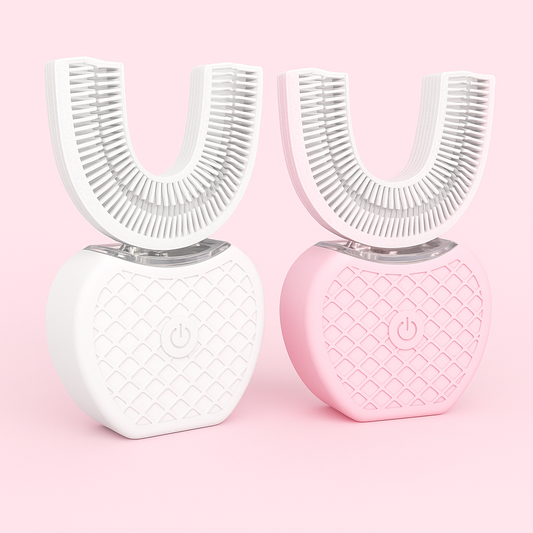Introduction — Brighten and strengthen without fluoride
A brighter smile doesn’t have to mean harsh chemicals or aggressive scrubbing. In 2025, many people seek fluoride-free alternatives that still deliver stain reduction and long-term oral health benefits. This comprehensive guide explains how to build a fluoride-free whitening routine centered on niacinamide toothpaste and toothpaste with xylitol, why those ingredients matter, how to choose the toothpaste whitening best suited to your needs, and practical daily habits that lead from stains to strength.
What you’ll learn in this article
- How niacinamide and xylitol work and why they’re useful in fluoride-free formulas
- How to choose a good whitening toothpaste and spot deceptive claims
- A step-by-step fluoride-free routine (morning, evening, weekly, and monthly)
- Diet, lifestyle and professional options that accelerate safe whitening
- An actionable 30-day plan and troubleshooting tips
Understanding tooth staining: what causes discoloration?
Before building a routine, identify the type of discoloration you have:
- Extrinsic stains: Surface staining from coffee, tea, wine, tobacco and highly pigmented foods. These respond best to good whitening toothpaste and professional cleaning.
- Intrinsic stains: Deeper discoloration within the tooth structure caused by aging, tetracycline, trauma, or certain medical conditions. These often need professional in-office or supervised at-home treatments.
- Enamel wear and dentin exposure: When enamel thins, the naturally yellower dentin shows through and whitening toothpaste alone has limited effect.
The science: how whitening works (and what it doesn’t do)
Whitening approaches fall into three categories:
- Mechanical removal: Mild abrasives and polishing agents remove surface stains.
- Chemical whitening: Peroxide-based agents oxidize pigmented molecules (often used under guidance).
- Supportive care: Ingredients that reduce bacterial acids, soothe gums, and improve the oral environment so stains are less likely to form.
Niacinamide and xylitol are primarily supportive; they don’t bleach teeth like professional peroxide treatments, but they help create conditions where stains are less likely to accumulate and enamel is better preserved.
Niacinamide toothpaste — what it is and why it helps
Niacinamide (vitamin B3) is increasingly used in oral care for its anti-inflammatory and epithelial-supporting properties. In toothpaste formulations, niacinamide toothpaste can:
- Support healthier gums by modulating inflammation and promoting tissue resilience
- Reduce sensitivity when combined with other desensitizing agents
- Improve the oral environment, making it easier to maintain whiteness over time
While niacinamide is not a direct stain-remover, healthier gums and less inflammation reduce plaque accumulation and create a cleaner surface for mechanical whitening to be more effective.
Xylitol in toothpaste: how a sugar substitute protects and preserves
Xylitol is a sugar alcohol that cariogenic bacteria (like Streptococcus mutans) cannot metabolize. The benefits of toothpaste with xylitol include:
- Lower acid production in the mouth, reducing demineralization of enamel
- Support for a healthier oral microbiome, which indirectly reduces discoloration from decay
- Improved saliva properties and potential remineralization support when combined with calcium/phosphate actives
Using toothpaste with xylitol is a strategic move if you prefer toothpaste without fluoride but want to support enamel and reduce cavity drivers.
Fluoride-free vs fluoride toothpaste — balanced perspective
Fluoride is the most well-established anticavity agent. Choosing a fluoride-free toothpaste is a personal preference for many reasons (sensitivity, ingredient avoidance, natural product preferences). If you choose fluoride-free:
- Prioritize ingredients that support enamel and reduce bacterial acid (xylitol, calcium/phosphate complexes, casein phosphopeptide-amorphous calcium phosphate in some formulas)
- Be aware that eliminating fluoride may increase cavity risk for some—consult your dentist, especially for children or people with high decay risk
- Regular professional check-ups and cleanings become more important
How to choose the best toothpaste whitening options without fluoride
When searching for a good whitening toothpaste or toothpaste that whitens teeth without fluoride, consider these criteria:
- Ingredient transparency: Full label listing, clear concentrations, and third-party testing if possible
- Low-to-moderate abrasivity: Look for a low Relative Dentin Abrasivity (RDA) to avoid enamel wear
- Supportive actives: Xylitol, niacinamide, calcium/phosphate, green tea polyphenols, or potassium nitrate for sensitivity
- Safe chemical whiteners: If present, low-concentration peroxide or sodium bicarbonate used appropriately
- Clinical claims: Prefer products with clinical studies or peer-reviewed support
- Positive reviews and reputable retailers: Look at verified reviews and seller transparency
For easy shopping, check curated sections for toothpaste without fluoride and toothpaste with xylitol such as the product pages at Havana Body to compare ingredients and benefits.
Daily fluoride-free whitening routine (step-by-step)
Adopt a routine that balances stain removal with enamel protection. Here’s a practical morning-evening plan:
-
Morning
- Brush 2 minutes with a niacinamide toothpaste or a formula that includes xylitol. Use a soft-bristled brush and pea-sized paste.
- Rinse with plain water or a xylitol mouthwash to reduce bacterial load after breakfast.
- If you consume coffee or tea, drink water afterward or use a straw when possible to reduce stain contact.
-
Midday (if possible)
- Chew sugar-free gum with xylitol after meals to stimulate saliva and neutralize acids.
- Rinse mouth after staining foods or drinks.
-
Evening
- Floss thoroughly to remove food and plaque between teeth.
- Brush again using a niacinamide toothpaste or toothpaste with xylitol, focusing on gentle technique.
- Consider a night-time xylitol rinse if your dentist recommends it for cavity prevention.
Weekly and monthly add-ons
- Weekly: Use a gentle whitening polish or a dentist-recommended whitening toothpaste once or twice a week; avoid daily abrasive use.
- Monthly: Track progress with photos and consider a professional cleaning; scaling and polishing remove most extrinsic stains.
- Quarterly or per dentist advice: Evaluate need for supervised whitening strips or in-office whitening for intrinsic stains.
30-day fluoride-free whitening plan (practical)
Progressively introduce habits to see safe results in about a month:
- Days 1–7: Switch to a niacinamide toothpaste with xylitol. Brush gently twice a day, floss nightly, and avoid obvious stain culprits in the evening.
- Days 8–14: Add sugar-free xylitol gum after meals and use a once-weekly mild whitening polish. Track appearance with a weekly photo.
- Days 15–21: Schedule a dental cleaning if due. Continue consistent brushing and hydration. Consider a targeted at-home whitening product (consult your dentist first).
- Days 22–30: Reassess sensitivity, appearance, and habits. If needed, pursue a dentist-supervised peroxide treatment for tougher intrinsic stains.
Diet and lifestyle: what to eat and avoid for whiter teeth
- Limit coffee, black tea, red wine, beetroot, curry, and tobacco — these are major extrinsic stain offenders.
- Consume crunchy, fibrous fruits and vegetables (apples, carrots) that help mechanically clean tooth surfaces.
- Include dairy, nuts, and leafy greens to support enamel health with calcium and phosphorus.
- Stay hydrated — water rinses away staining particles and supports saliva flow.
Professional treatments: when to seek help
If stains are deep, progress is minimal after consistent home care, or you experience sensitivity and pain, see a dental professional. Options include:
- Professional polishing and scaling to remove surface stains and calculus
- Custom at-home bleaching trays or in-office peroxide treatments for intrinsic stains
- Veneers or bonding for severe discoloration or enamel defects
Common myths and mistakes
- Myth: Abrasive whitening always works faster. Reality: Overly abrasive pastes can permanently thin enamel and increase yellowing.
- Myth: All natural toothpastes are safer. Reality: "Natural" doesn’t guarantee low abrasivity or clinical efficacy.
- Mistake: Replacing dental visits with at-home whitening. Regular professional care is essential for long-term health teeth maintenance.
How to read labels — ingredients to favor and avoid
Favor: xylitol, niacinamide, calcium/phosphate complexes, potassium nitrate for sensitivity, low-abrasion polishing agents, and clinically-supported extracts. Avoid: high abrasive silica without RDA data, unregulated bleaching agents at unsafe concentrations, and unclear "instant whitening" claims without evidence.
Where to shop and how to compare products (SEO-friendly guidance)
When searching keywords like "best toothpaste whitening teeth," "toothpaste without fluoride," or "toothpaste that whitens teeth," compare products across these dimensions: ingredient list, RDA (if available), clinical studies, user reviews, and brand transparency. For curated options, ingredient comparisons, and product pages focused on fluoride-free whitening formulas, explore specialized retailers such as Havana Body. Look for pages that highlight "good whitening toothpaste," "toothpaste with xylitol," and "niacinamide toothpaste" to compare benefits and choose the right solution for your needs.
Extended FAQs (practical answers)
- Can niacinamide toothpaste whiten teeth? Niacinamide supports gum and soft tissue health rather than directly bleaching teeth. When paired with safe polishing agents, niacinamide toothpaste contributes to a brighter-looking smile over time by improving the oral environment.
- How long before I see whitening results without fluoride? For surface stains, expect 2–8 weeks of consistent care. Deep intrinsic staining may require professional intervention.
- Is toothpaste with xylitol safe for children? Xylitol is generally safe but consult your pediatrician or pediatric dentist for age-appropriate formulations and swallowing risks. For young children, fluoride decisions should be guided by a dental professional.
- Will avoiding fluoride cause cavities? Removing fluoride can increase risk in susceptible individuals. If you choose fluoride-free, ensure additional protective measures (xylitol, regular cleanings, dietary control) and consult your dentist.
- Can I combine a fluoride-free toothpaste with professional whitening? Yes. Professional whitening targets stains chemically and can be used regardless of whether you use fluoride at home. Discuss compatibility with your dental provider.
Troubleshooting — common concerns and quick fixes
- Increased sensitivity: Reduce abrasive products, use a desensitizing toothpaste, and discuss potassium nitrate or fluoride varnish with your dentist.
- Slow results: Confirm you’re using a safe polishing product and schedule a professional cleaning; consider supervised peroxide treatments for stubborn stains.
- Poor gum health: Prioritize niacinamide toothpaste and professional periodontal care; healthy gums support long-term whiteness.
Tracking progress and realistic expectations
Take a photo at the start and weekly under natural light to track changes. Notice improvements in brightness, reduced staining between teeth, and decreased sensitivity. True, long-lasting whitening is gradual and maintained by consistent habits.
Final checklist before you commit
- Confirm your product lists xylitol and/or niacinamide if those are priorities
- Check abrasivity and avoid high-RDA options
- Plan for regular dental cleanings and professional guidance if you have a history of cavities
- Set realistic outcomes: surface stain reduction is usually achievable; intrinsic whitening may need professional care
Conclusion — move from stains to strength with confidence
Switching to a fluoride-free whitening routine that centers on niacinamide toothpaste and toothpaste with xylitol can give you progressive, safe improvements in tooth brightness while supporting gum health and the oral microbiome. The keys are consistent gentle technique, ingredient-aware product selection, smart dietary choices, and regular professional care. For many people seeking "toothpaste whitening best" options or searching for "fluoride toothpaste free" solutions, this balanced approach offers both cosmetic and health benefits.
If you’re ready to explore curated fluoride-free whitening products, compare formulas, or purchase trusted niacinamide and xylitol toothpastes, visit Havana Body to find options tailored to your needs. Discover their selection of good whitening toothpaste, dedicated toothpaste without fluoride, and advanced toothpaste with xylitol — and take the next step toward a healthier, whiter smile today.


